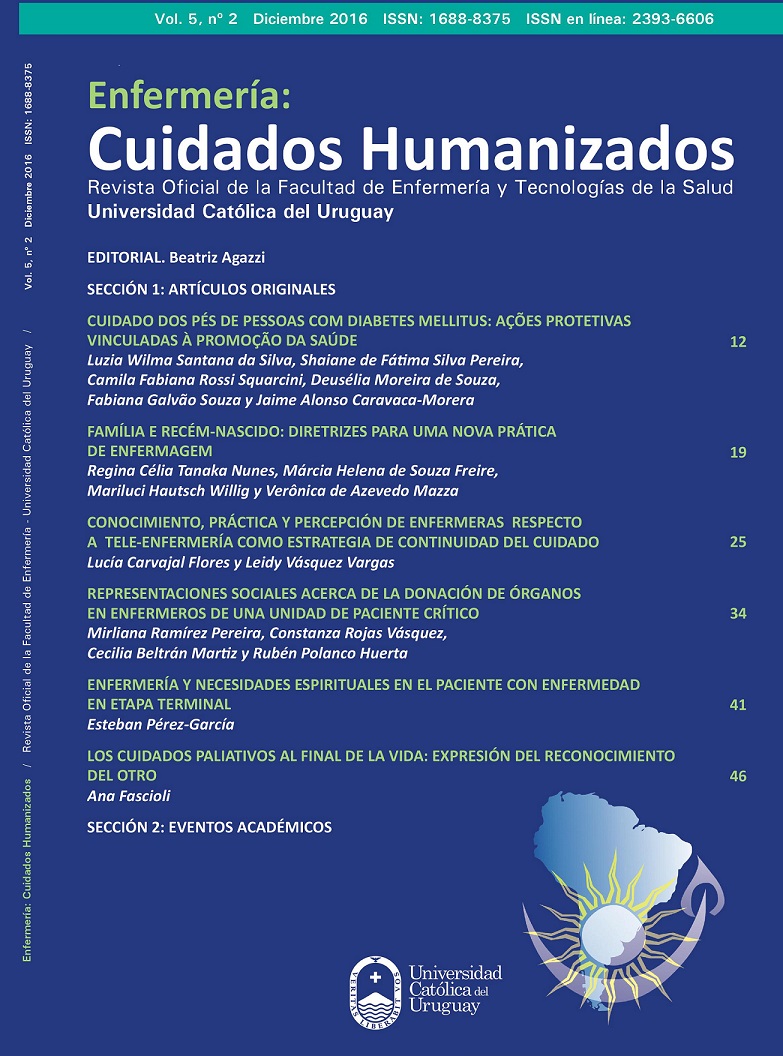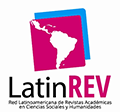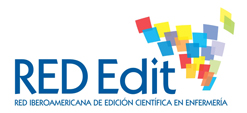FAMILY AND THE NEWLY BORN: GUIDELINES FOR A NEW NURSING PRACTICE
DOI:
https://doi.org/10.22235/ech.v5i2.1283Keywords:
maternal-child nursing, nursing care, family relations, newborn, health planning guidelinesAbstract
The purpose of this research is to identify the nursing team’s contributions to the construction of family bonding with the newborn for the development of a new care guideline. It is a descriptive qualitative study, based in the Problem-based Methodology with the participation of 20 nursing professionals who belonged to the Woman and Newborn Health-care Unit. Data collection, by means of Education Practice Workshops, was carried out between October and November 2012. Three thematic categories emerged from the analysis and interpretation of the qualitative data obtained in the workshops: a) Nursing care contributions to the construction of the family bonding with the neonate; b) Nursing care limitations for the construction of the family bonding with the neonate; c) Nursing care guidelines for the construction of the family bonding with the neonate. It was evidenced that the reflection held in the practice workshops enabled the team participation in the development of guidelines in order to build the family bonding with the neonate. However, nursing care needs to integrate with the other sectors to strengthen the network building of institutional humanized care.Downloads
References
Brüggemann OLM, Parpinelli MA, Osis MJD. Apoio no nascimento: percepções de profissionais e acompanhantes escolhidos pela mulher. Rev Saúde Pública. 2007;41(1):44-52.
Aquino EML. Reinventing delivery and childbirth in Brazil: back to the future. Cad. Saúde Pública. 2014;30 Sup: S8-S10.
Diniz CSG, D'Orsi E, Domingues RMSM, Torres JA, Dias MAB, Schneck CA etal. Implementation of the presence of companions during hospital admission for childbirth: data from the Birth in Brazil national survey.
Cad. Saúde Pública. 2014; 30 Sup: S140-S153. doi: org/10.1590/0102-311X00127013
Rance S, McCourt C, Raymente J, Mackintosh N, Carter W, Watson K, et al. Women’s safety alerts in maternity care: is speaking up enough? BMJ Qual Saf. 2013;22:348-355.
Presidência da República - Brasil. Lei n° 11.108 de 07 de abril de 2005. Altera a Lei no 8.080, de 19 de setembro de 1990, para garantir as parturientes o direito à presença de acompanhante durante o trabalho de parto, parto e pós-parto imediato, no âmbito do Sistema Único de Saúde - SUS. Presidência da República: Brasília (DF), 2005.
Soares RKC, Silva SF, Lessa PRA, Moura ERF, Pinheiro PNC, Damasceno AKC. Parturient´s companion and the relationship with the nursing team: a qualitative study. [Internet] 2010 [citado: 22 Abr 2015] http://www.objnursing.uff.br/index.php/nursing/article/view/j.16764285.2010.
Teles LMR, Pitombeira HCS, Oliveira AS, Freitas LV, Moura ERF, Damasceno AKC. Parto com acompanhante e sem acompanhante: a opinião das puérperas. Cogitare Enferm. 2010;15(4):688-694.
Berbel NAN. A metodologia da problematização com o Arco de Maguerez:uma reflexão teórico-epistemológica. Londrina: EDUEL, 2012.
Bardin L. Análise de Conteúdo.Lisboa, Portugal: Edições 70, 2009.
Rodrigues DP, Silva RM, Fernandes AFC. Ação interativa enfermeiro-cliente na assistência obstétrica. Ver Enferm UFRJ. 2006;14(2):232-238.
Leal MC, Gama SGN. Nascer no Brasil. Cad. Saúde Pública, Rio de Janeiro, 30 Sup:S5, 2014. doi: org/10.1590/0102-311XED01S114
Santos LM, Carneiro CV, Carvalho ESS, Paiva MS. Percepção da equipe de saúde sobre a presença do acompanhante no processo parturitivo. Rev RENE. 2012;13(5):994-1003.
Hodnett ED, Gates S, Hofmeyr GJ, Sakala C. Continuous support for women during childbirth. Cochrane Database of Systematic Reviews. 2012; 10 (CD003766). doi: 10.1002/14651858.CD003766.pub4.
Longo CSM, Andraus LMS, Barbosa MA. Participação do acompanhante na humanização do parto e sua relação com a equipe de saúde. Ver Eletr Enf. 2010;12(2):386-391.
Hoga LAK, Pinto CMS. Assistência ao parto com a presença do acompanhante: Experiências de profissionais. Universidad de Antioquia. Facultad de Enfermería. Invest Educ Enferm. 2007; 25(1), p. 74-81.
Yuenyong S, O’Brien B, Jirapeet V. Effects of labor support from close female relative on labor and maternal satisfaction in a Thai setting. Journal of Obstetric, Gynecologic, & Neonatal Nursing 2012;41(1):45–56.
Cardinali F, Aires LCP, Monticelli M, Correia DS, Mendes L, Alcântara MG. O acompanhante no alojamento conjunto da maternidade. Rev Enferm UFSM. 2011;1(1):1-14.
Couto FF, Praça NS. Recém-nascido prematuro: suporte materno domiciliar para o cuidado. Rev Bras Enferm. 2012;65(1):19-26.
Organização Mundial da Saúde – OMS. Fundo das Nações Unidas para a Infância - UNICEF. Iniciativa Hospital Amigo da Criança: revista, atualizada e ampliada para o cuidado integrado - módulo 1: histórico e implementação/Fundo das Nações Unidas para a Infância. – Brasília: Ministério da Saúde, 2008. 78 p.
Matos TA, Souza MS, Santos EKA, Velho MB, Seibert ERC, Martins NM. Contato precoce pele a pele entre mãe e filho: significado para mães e contribuições para a enfermagem. Ver Bras Enferm. 2010;63(6):998-1004.
Pessati M P. Estratégias para a Ambiência na Humanização de Partos e Nascimentos. Caderno Humanizasus. Brasília, Ministério da Saúde, 2014. p. 171-182.
Brasil, Ministério da Saúde. Agência nacional de Vigilância Sanitária. Resolução nº 36, de 03 de junho de 2008. Dispõe sobre Regulamento Técnico para Funcionamento dos Serviços de Atenção Obstétrica e
Neonatal. [Internet] 2008 [citado: 22 Jun 2015] http://bvsms. saude.gov.br/bvs/saudelegis/anvisa/2008/res003603062 00 8rep.html
Brasil. Ministério da Saúde. Secretaria de Atenção à Saúde. Núcleo
Técnico da Política Nacional de Humanização. HumanizaSUS: Documento base para gestores e trabalhadores do SUS / Ministério da Saúde, Secretaria de Atenção à Saúde, Núcleo Técnico da Política Nacional de Humanização. – 4ª ed. Brasília: Editora do Ministério da Saúde, 2010. 72 p.
Duarte EE, Sena RR, Dittz ES, Tavares TS, Lopes AFC, Silva PM. A família no cuidado do recém-nascido hospitalizado: possibilidades e desafio na construção da integralidade. Texto Contexto Enferm. 2012;21(4):870-878.
Downloads
Published
How to Cite
Issue
Section
License
Copyright (c) 2016 Enfermería: Cuidados Humanizados

This work is licensed under a Creative Commons Attribution 4.0 International License.

















